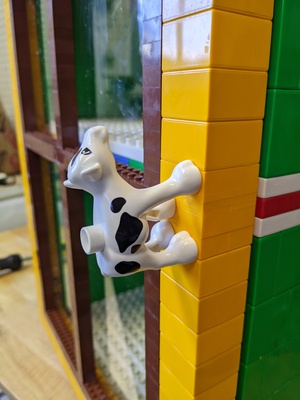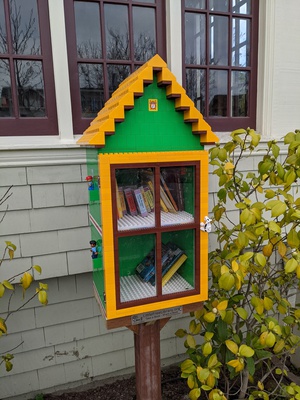Welcome!
If you're a visitor to the LEGO Little Library, welcome!
Please feel free to take and/or leave a book or books! All manner of books are welcome, not just children's books! If you're curious to know more about the library, read on.
Origin
The first Little Free Library I remember encountering is on Clayton Street in the Cole Valley neighborhood of San Francisco. That library is a miniature version of the Victorian house that sits behind it. When my family moved to Berkeley a few months before the COVID-19 shelter-in-place began, I started noticing little libraries everywhere. I began routing my daily walks around the neighborhood to pass by as many of them as possible, and they became popular destinations on bike rides with my preschool-aged children.
I tucked this away as a fun “some day” project for our own yard. We were getting desperate for a way to pass along some of the books my kids were outgrowing, and it seemed like it could a fun way to engage with our new neighborhood. I also assumed (at the time) that it would be a manageably-sized woodworking project.
It wasn’t until about December 2020 that I started to consider whether the library could be built out of LEGO. By this point, I had wrapped up another large LEGO project and was starting to look for a new one. My children were also starting to spend less time with DUPLO in favor of standard-sized LEGO – could this be a new home for the old DUPLO bricks?
Design
I did the design in BrickLink Studio with the help of a custom DUPLO parts package.



Working with DUPLO imposed a few interesting constraints.
First, all DUPLO bricks have to be large enough to avoid becoming choking hazards. In particular, there are no DUPLO equivalents to the LEGO 1x1 brick or 1x2 brick. That, combined with the staggered layers of bricks, led to the “square wave” pattern visible along the front inside edges of the library.

DUPLO also has a much more limited inventory of pieces than LEGO. Many kinds of pieces simply don’t exist, including hinges that allow for rotation in a horizontal plane or pieces that would enable the Studs Not On Top (“SNOT”) technique. The combination of these two factors meant I ended up using a small number of non-DUPLO LEGO parts for the window muntins in the door (they are compatible!) and a few non-LEGO parts (hinges, bolts, and the and magnetic clasp). The door handle is attached purely with glue.



Finally, the online market for DUPLO is far smaller than for LEGO, so some of the color choices were dictated by what pieces were actually available in the world. The project ultimately required twelve shipments from five countries (Germany, Hungary, Netherlands, Russia, and the US), adding up to approximately 1,000 pieces. So much for building it out of the old DUPLO!
Construction and Installation
LEGO is strong in compression but weak in tension. When I went looking for a good glue option, I found many posts discouraging parents from applying glue to their children’s old LEGO models (and LEGO doesn’t “think it’s a good idea to use any type of glue on LEGO bricks”). I ended up using ZAP-A-GAP CA+ (Green Label) based on the advice in this post. It feels very sturdy, but the long-term durability of this approach remains to be seen.
One thing I learned during construction is that DUPLO bricks have a much looser fit than LEGO bricks – but this flexibility goes away almost immediately as the glue sets. It’s possible to glue a brick such that it appears to be aligned correctly but actually isn’t, and this error can accumulate over time as layers are added. I figured out late in the gluing process that placing a “spacer” plate on top of each new layer (before the glue sets) can help to ensure proper alignment.
Once the library and door were fully glued, I attached a sheet of clear acryllic to the inside of the door with small screws, attached the hinges with bolts through holes drilled in the LEGO, and added a magnetic clasp for the door with a combination of screws and glue. I applied clear silicone caulk to the roof to improve the water resistance. I’m not sure how well it will hold up in a torrential downpour (and the walls are porous), but so far it has kept the books dry.
The library is bolted to a wooden platform that sits on top of a pressure-treated 4x4 that’s embedded in 2’ of soil. In the week leading up to the installation, my kids (and I) got a kick out of watching workers from the various utility companies spraypaint different colors on our sidewalk to mark the location of the underground utilities.



Maintenance and Restocking
We weren’t sure what to expect with respect to ongoing maintenance and restocking, but so far it has been entirely hands off. We provided an initial stock of children’s books; since then, folks have been adding their own. Supply seems to ebb late in the week and be replenished on the weekends. We haven’t had any issues with vandalism or garbage so far.
February 2023 Update: We’ve had to throw away the odd non-book item every now and then, and one “pane” of the acryllic has broken (though it doesn’t seem to have resulted in significant moisture intrusion).